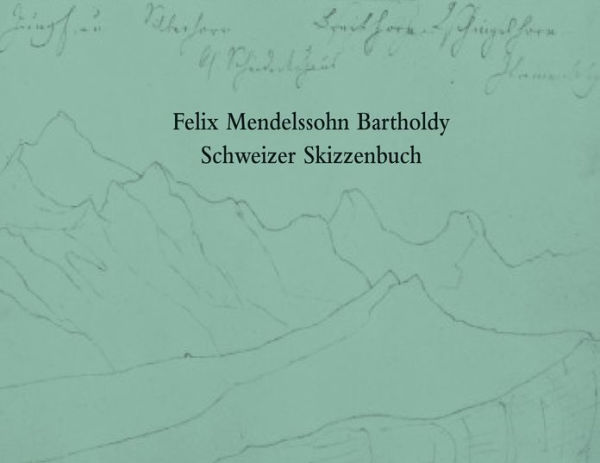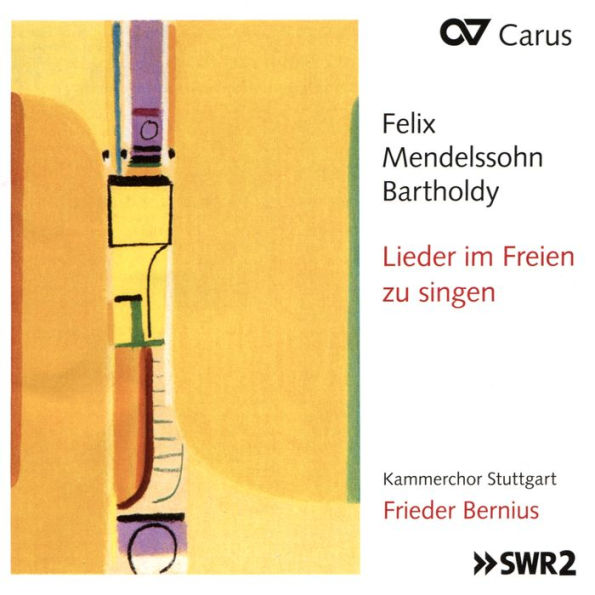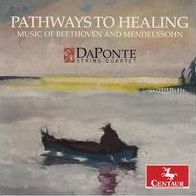Home
Felix Mendelssohn Bartholdy. Schweizer Skizzenbuch
Barnes and Noble
Felix Mendelssohn Bartholdy. Schweizer Skizzenbuch
Current price: $74.00


Barnes and Noble
Felix Mendelssohn Bartholdy. Schweizer Skizzenbuch
Current price: $74.00
Size: OS
Loading Inventory...
*Product information may vary - to confirm product availability, pricing, shipping and return information please contact Barnes and Noble
English summary: In 1842 Felix Mendelssohn Bartholdy had the intention of travelling to the Alps again - this time along with his wife Cecile, who did not know Switzerland. When an invitation from the Swiss music society to participate in the music festival in Lausanne, where they wanted to perform his "Lobgesang" op. 52 in his presence, arrived, the planning for the journey started to take shape. It was also arranged that his brother Paul and his wife Albertine should join the party. On the 16th of July 1842 Felix Mendelssohn returned with his wife from England to his mother-in-law's house in Frankfurt. Early in the morning, before the others got up, he often walked to the south of the city where he took his drawing pencil in his hand. At the end of July Paul and Albertine arrived on the Main and soon afterwards the travelling group set off; Felix's and Cecile's small children stayed with their relatives in Frankfurt.In Basel the continuation of the journey and therefore their arrival in Lausanne had to be delayed, due to the indisposition of Cecile Mendelssohn. They had chosen a route which led from here through Delemont and the valley of Birs (with a stop in the village of Court on the 2nd of August) to Biel (on the 3rd of August); on the 4th of August they arrived at Lake Geneva, one day after the performance of "Lobgesang". On the 5th and 6th they stayed in Ouchy and on the 6th they even took part in a steamship journey on the lake, which marked the end of the music festival. The following day was the last one in Lausanne, Mendelssohn drew one of his most beautiful views in his sketch book, the town cathedral.Passing Geneva they travelled to the Valley of Arve and after a stop in Bonneville they reached Chamonix where they stayed for a couple of days. Passing through the Dala gorge they reached Leukerbad, and from here they climbed to the Gemmi Pass and to Lake Dauben. At which stage of the journey the group passed the Kandersteg and Spiez and reached Interlaken is not known. From their base in Interlaken the Mendelssohns made excursions to the Berner Oberland, on the 21st of August to Wengen, on the 22nd and 23rd to the Faulhorn, the mountain with a much esteemed panorama, which was easy to reach and on which one could also spend the night. Finally they reached Zurich on the 2nd of September and then returned to Frankfurt.Mendelssohn did not write a diary during his journey and did not send his family in Berlin such detailed reports as he had done in 1831. He writes to his mother: "It is impossible to describe Switzerland, and instead of writing a diary this time I am drawing ferociously, sitting in front of a mountain and trying to capture its likeness (until the drawing is ruined, only then do I stop) und each day I must have at least one landscape in my book" (18/8/1842). During his journey Mendelssohn used at least two sketch books, the one given in facsimile here, which is now in Berlin, and another one which is kept in Oxford and begins with Court on the 2nd of August and closes with Stans on the 30th of August. It is not clear whether he kept a third sketch book, now missing. That he noted on each individual sheet both the place and the date of its origin indicates that they were primarily meant to function as remembrances, in the sense of a kind of diary, just as he himself explained in the previously quoted letter to his mother. The individual identifications are to be taken in the same sense. In the facsimile part, Mendelssohn's entries are reproduced at the front on the left-hand commentary pages in cursive script, in their entirety and reproducing Mendelssohn's spelling and punctuation faithfully.Mendelssohn's drawings are elaborated in greatly different ways. Some are only sketched in outline, whereby he occasionally made notes in the form of words or abbreviations as a mnemonic for further elaboration, which however remained undone. It has been recorded that during his journey in 1831 he often continued working on his drawings in a tavern in the evening; to what extent he did it this time too is not known (most likely he did not). His view of Bonville (8/8) allows us to see that, after sketching the houses that form the frame for the picture, he immediately focusses on the cliff, but which he still did not finished - obviously it was the mountain which had aroused his particular interest. Therefore the sheets sometimes provide the impression of the status nascendi. Even the drawings that appear at first glance to be complete have only scetched outlines at the edges and are not perfectly elaborated - as apparently was Mendelssohn's ideal. Yet this may - as in the picture of Frankfurt (20/7), for example - be a stylistic device deliberately used to focus the viewer's attention on the centre of the picture. With mountains in the distance, areas left white could represent the haze, through which the peaks appear only as an silhouette; on the other hand, his view of the Bach Alp (22/8) clearly shows how Mendelssohn indicated the different distances of the groups of mountains through his manner of drawing details, without at the same time abandoning the elaboration of the background. This technique may also have arisen from the fact that Mendelssohn wanted to capture as much of the scene as possible for his own memories, whilst faithful reproduction in the sense of an veduta was not so important to him. Neverthelss, these drawings drawings are amongst his most beautiful works. German description: Im Jahre 1842 hatte Felix Mendelssohn Bartholdy wieder die Absicht, in die Alpen zu fahren - diesmal mit seiner Frau Cecile, die das Schweizer Land nicht kannte. Als dann eine Einladung der Schweizerischen Musikgesellschaft eintraf, am Musikfest in Lausanne teilzunehmen, wo man seinen "Lobgesang", op. 52, in seiner Gegenwart auffuhren wollte, gewann die Reiseplanung deutlichere Konturen. Es war auch verabredet worden, dass der Bruder Paul mit seiner Frau Albertine auf die Reise mitkommen sollte. Felix Mendelssohn war mit seiner Frau am 16. Juli 1842 aus England nach Frankfurt in das Haus seiner Schwiegermutter zuruckgekommen und unternahm nun oft am fruhen Morgen, bevor die anderen aufstanden, eine Wanderung in den Suden der Stadt, wo er dann auch schon zum Zeichenstift griff. Ende Juli trafen dann Paul und Albertine am Main ein und bald darauf brach die Reisegruppe auf; Felix' und Ceciles kleine Kinder blieben bei den Verwandten in Frankfurt.In Basel verzogerte sich wegen einer Unpasslichkeit Cecile Mendelssohns die Weiterreise und damit auch die Ankunft in Lausanne. Sie hatten eine Reiseroute gewahlt, die von hier aus uber Delemont durch das Tal der Birs (mit Halt im Dorfe Court am 2. August) nach Biel führte (am 3.8.); am 4.8. trafen sie am Genfer See ein, einen Tag nach der Auffuhrung des "Lobgesang". Am 5. und 6. August hielten sie sich in Ouchy auf und nahmen am 6. auch an einer Dampferfahrt auf dem See teil, mit der das Musikfest abgeschlossen wurde. Der darauffolgende Tag war der letzte in Lausanne, Mendelssohn zeichnete eine seiner schonsten Ansichten in sein Skizzenbuch, die Kathedrale der Stadt.Uber Genf fuhr man in das Tal der Arve und gelangte nach einem Halt in Bonneville nach Chamonix, wo man sich fur einige Tage einmietete. Durch die Dala-Schlucht erreichten sie Leukerbad, und von hier aus stiegen sie zum Gemmi-Pass und zum Daubensee hinauf. In welchen Tagesetappen dann die Gruppe uber Kandersteg und Spiez nach Interlaken kam, ist nicht bekannt. Von Interlaken aus unternahmen die Mendelssohns dann Ausfluge ins Berner Oberland, am 21.8. nach Wengen, am 22./23.8. auf das Faulhorn, den Berg mit einem viel gepriesenen Panorama, den man auch relativ leicht erreichen und auf dem man auch ubernachten konnte. Am 2.9. erreichten sie schliesslich Zurich, von wo aus sie nach Frankfurt zuruckkehrten.Mendelssohn hat wahrend der Reise kein Tagebuch geführt und seiner Familie in Berlin auch nicht so ausfuhrliche Berichte geschickt, wie er es 1831 getan hatte. An seine Mutter schreibt er: "Schweizer Beschreibungen sind ja gar nicht zu machen, und statt eines Tagebuchs, wie das vorigemal, zeichne ich diesmal ganz wuthig darauf los, und sitze Tagelang vor einem Berge, und suche ihn nachzumachen, (bis das Bild verdorben ist, eher lasse ich nicht ab) und muss taglich wenigstens eine Landschaft im Buch haben" (18.8.1842). Mendelssohn hat mindestens zwei Zeichenbucher wahrend der Reise benutzt, das hier faksimilierte, das heute in Berlin liegt, und ein weiteres, das in Oxford aufbewahrt wird und mit Court am 2.8. beginnt und mit Stans am 30.8. endet. Ob er noch ein drittes, heute verschollenes Skizzenheft geführt hat, ist nicht sicher. Die Bezeichnung der einzelnen Blatter mit Ort und Datum ihrer Entstehung lasst deutlich erkennen, dass sie primar als Erinnerungsstucke dienten, im Sinne einer Art Tagebuch, wie er es selbst in dem zitierten Brief an die Mutter beschrieben hat. In demselben Sinne sind die einzelnen Identifikationshinweise zu deuten. Diese Eintragungen Mendelssohns sind im Faksimile-Teil jeweils auf der linken Kommentarseite zu Beginn in kursiver Schrift wiedergegeben, vollstandig und in Mendelssohns Orthographie und Interpunktion. Die Zeichnungen Mendelssohns sind in sehr unterschiedlicher Weise ausgearbeitet. Einige sind nur in ihren Umrisslinien skizziert, wobei er sich gelegentlich auch in Worten oder Kurzeln Gedachtnisstutzen fur die weitere Ausarbeitung notiert hat, die dann aber unterblieb. Uberliefert ist, dass er auf seiner Reise 1831 oft noch abends im Wirtshaus an seinen Zeichnungen weitergearbeitet hat; inwieweit er dies auch jetzt getan hat, ist nicht bekannt (zu vermuten ist: wohl eher nicht). Die Ansicht von Bonneville (8.8.) lasst erkennen, wie er nach Skizzierung des Hauser-"Rahmens" sich gleich auf das Felsenmassiv konzentriert, das aber doch nicht beendet hat - offensichtlich war es der Berg, der sein besonderes Interesse erregt hatte. So vermitteln die Blatter gelegentlich den Eindruck des status nascendi. Auch die Zeichnungen, die auf den ersten Blick als beendet erscheinen, weisen in Randpartien nur eine skizzierte Ausfuhrung auf, sie sind nicht bis zu Ende ausgearbeitet - wie es doch wohl Mendelssohns Ideal gewesen ist. Doch konnte dies - wie beispielsweise in dem Frankfurter Bild (20.7.) - ein absichtsvoll eingesetztes kunstlerisches Mittel sein, um die Konzentration auf den Bildmittelpunkt zu bewirken. Bei Bergen in der Ferne konnten weiss gebliebene Flachen den Dunst wiedergeben, in dem die Gipfel nur als Silhouette erscheinen; andererseits lasst die Ansicht der Bachalp (22.8.) deutlich erkennen, wie Mendelssohn durch die Art der Detailzeichnung die unterschiedliche Entfernung der Berggruppen angedeutet hat, ohne dabei auf eine Ausarbeitung des Hintergrundes zu verzichten. Auch diese Technik konnte dadurch bedingt sein, dass Mendelssohn fur die eigene Erinnerung moglichst viel von dem Gesehenen festhalten wollte, wobei die realitatsgetreue Wiedergabe im Sinne einer Vedute ihm nicht so wichtig war. Einige Bilder aus diesem "Schweizer Skizzenbuch" gehoren zu seinen schonsten Zeichnungen.


















